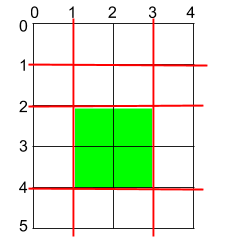矩形蛋糕的高度为 h 且宽度为 w,给你两个整数数组 horizontalCuts 和 verticalCuts,其中:
-
horizontalCuts[i]是从矩形蛋糕顶部到第i个水平切口的距离 verticalCuts[j]是从矩形蛋糕的左侧到第j个竖直切口的距离
请你按数组 horizontalCuts 和 verticalCuts 中提供的水平和竖直位置切割后,请你找出 面积最大 的那份蛋糕,并返回其 面积 。由于答案可能是一个很大的数字,因此需要将结果 对 109 + 7 取余 后返回。
示例 1:

输入:h = 5, w = 4, horizontalCuts = [1,2,4], verticalCuts = [1,3] 输出:4 解释:上图所示的矩阵蛋糕中,红色线表示水平和竖直方向上的切口。切割蛋糕后,绿色的那份蛋糕面积最大。
示例 2:

输入:h = 5, w = 4, horizontalCuts = [3,1], verticalCuts = [1] 输出:6 解释:上图所示的矩阵蛋糕中,红色线表示水平和竖直方向上的切口。切割蛋糕后,绿色和黄色的两份蛋糕面积最大。
示例 3:
输入:h = 5, w = 4, horizontalCuts = [3], verticalCuts = [3] 输出:9
提示:
2 <= h, w <= 1091 <= horizontalCuts.length <= min(h - 1, 105)1 <= verticalCuts.length <= min(w - 1, 105)1 <= horizontalCuts[i] < h1 <= verticalCuts[i] < w- 题目数据保证
horizontalCuts中的所有元素各不相同 - 题目数据保证
verticalCuts中的所有元素各不相同
1.分治法:每次切割都将原来的图分割成两部分,然后对于被分割出来的两部分再进行分割,直到不能分割为止。剪枝:先对分割序列进行排序,这样就可以实现:先从上往下横着切,再从左到右竖着切。这样一来,对于横切部分,划分成上下两半,(若升序排序)上半边已经不会再被切割了,所以对上半边进行递归的时候可以把水平切割队列置空;对于竖切部分同理。
1 class Solution
2 {
3 public:
4 vector<int> none;
5 long long max_area = 0;
6 long long mod = 1e9 + 7;
7 void divideArea(long long bx, long long by, long long ex, long long ey, vector<int> horizontalCuts, vector<int> verticalCuts)
8 { // bx、by为区域左上角坐标,ex、ey为区域右下角坐标
9
10 if (!horizontalCuts.empty())
11 {
12 int row = horizontalCuts.front();
13 horizontalCuts.erase(horizontalCuts.begin());
14 divideArea(bx, by, row, ey, none, verticalCuts); // 上部
15 divideArea(row, by, ex, ey, horizontalCuts, verticalCuts); // 下部
16 }
17 else if (!verticalCuts.empty())
18 {
19 int column = verticalCuts.front();
20 verticalCuts.erase(verticalCuts.begin());
21 divideArea(bx, by, ex, column, none, none); // 左部
22 divideArea(bx, column, ex, ey, none, verticalCuts); // 右部
23 }
24 else
25 { // 切割完毕,更新最大面积
26 max_area = max(max_area, (ey - by) * (ex - bx));
27 }
28 }
29 int maxArea(int h, int w, vector<int> &horizontalCuts, vector<int> &verticalCuts)
30 {
31 sort(horizontalCuts.begin(), horizontalCuts.end());
32 sort(verticalCuts.begin(), verticalCuts.end());
33 divideArea(0, 0, h, w, horizontalCuts, verticalCuts);
34 return max_area % mod;
35 }
36 };
该代码不能通过最后一组用例,因为空间复杂度爆了,暂时没找到优化的点,仅供思路参考。
2.贪心法:我们注意到他的每次切割都是水平或垂直的完全切割,也就是说每次不同方向切割都能相互影响(例如横切过2刀之后,蛋糕被分成了三块,此时竖切一刀,这时的三块蛋糕都会同时受到影响),所以我们只需考虑横切完后的最大间距和竖切完后的最大间距,他们围成的面积就是最大的。
1 class Solution
2 {
3 public:
4 long long mod = 1e9 + 7;
5
6 long long maxInterval(vector<int> arr, int border)
7 {
8 int mmax = border - *arr.rbegin(); //初值为最后一块的长度
9 int pre = 0;
10 for (int i : arr)
11 {
12 mmax = max(i - pre, mmax);
13 pre = i;
14 }
15 return mmax;
16 }
17 int maxArea(int h, int w, vector<int> &horizontalCuts, vector<int> &verticalCuts)
18 {
19 sort(horizontalCuts.begin(), horizontalCuts.end());
20 sort(verticalCuts.begin(), verticalCuts.end());
21 return maxInterval(horizontalCuts, h) * maxInterval(verticalCuts, w) % mod;
22 }
23 };
标签:vector,verticalCuts,int,horizontalCuts,long,力扣,1444,蛋糕,贪心 From: https://www.cnblogs.com/coderhrz/p/17793832.html